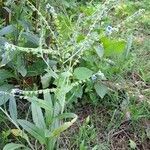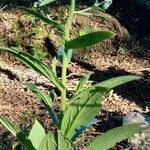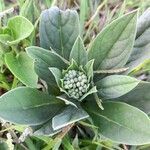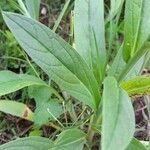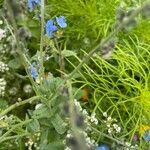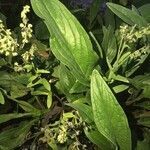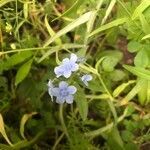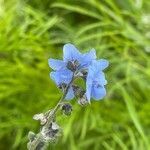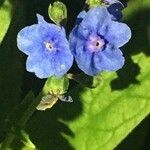Annual or biennial herb 0.3-1.2 m tall, branched from the base; rootstock ± simple, 6-10 cm long; stems woody at the base, densely adpressed velvety hairy, scarcely scabrid, ± ridged in dry state. Cauline leaves numerous and ± closely placed, narrowly oblong to lanceolate, 2-20 cm long, 0.4-4 cm wide, acute at the apex, sessile or ± amplexicaul at the base, densely adpressed softly velvety hairy on both surfaces; nervation impressed above, raised beneath, grey-green when dry; basal leaves up to 9 cm long, 1.5 cm wide with petioles to 4 cm long. Inflorescences terminal and axillary, forming a compound inflorescence ± 10 cm long in young state, extending to 35 cm; cymes 2-branched, each branch eventually 5-10 cm long; pedicels ± 2 mm long, becoming longer and deflexed in fruit, up to 4 mm long. Calyx ± 3 mm long, densely pubescent; lobes oblong-elliptic to ovate, 2 mm long, just over 1 mm wide, becoming more ovate and somewhat accrescent and 3 x 2 mm. Corolla intense blue, the limb ± 1 cm wide; tube 2.5 mm long, the throat with retuse finely papillose bosses; lobes rounded, ± 4 mm diameter. Anthers pale blue, 1 mm long, shortly protruding between the bosses. Style 2 mm long, narrowed at the apex. Nutlets whitish, depressed-ovoid, 3 mm long, 2-2.5 mm wide, covered all over with short glochidia, thickened towards the base, the outer ± forming a marginal serrated crest.
Perennial herbs, 15-60 cm high. Stems single, rarely several, erect, with dense, spreading hairs. Leaves velvety, greyish white, with distinct nerves on lower side, basal ones with a long petiole, 5-20 cm long, 2-3.5(-4) cm wide, oblong-lanceolate to lanceolate, acute at the apex, tapering into petiole; cauline leaves sessile with broad, rounded base, oblong to lanceolate, (2-)3-10 by up to 2.5 cm. Lowest cymes in the axils of upper leaves, upper ones crowded, at acute angles, erect, ebracteate; pedicels 2-3 mm long in flower, elongated to c. 4 mm and curved downwards in fruit. Calyx 2.5-3.5 mm long, greyish pubescent, lobes ovate, acutish, free to base. Corolla blue, rarely white, 5-6 mm long; tube c. 2.5 mm long, limb spreading, 7-10 mm in diam.; fornices papillate, trapeziform. Stamens: anthers subsessile between fornices, 1 mm long. Pistil: style twice as long as nutlets. Nutlets whitish, ovate in outline, 3-4 mm long, dorsally slightly concave to slightly convex, covered equally by glochids all over, the marginal glochids confluent at the base, nearly forming a wing; areola above middle of ventral surface.
Annual or biennial herb to c. 60 cm high. Stems and lvs densely clothed in fine grey hairs (appearing greenish in shade); hairs minutely bulbous-based, sometimes ± appressed. Basal lvs to c. 25 cm long; petiole to 10 cm long; lamina elliptic-lanceolate or elliptic-oblong; base attenuate or winged; apex obtuse, mucronate; cauline lvs smaller and sessile towards infl. Cymes tomentose; pedicels downward curving at fruiting. Calyx 2-3 mm long, to c. 5 mm long at fruiting, tomentose, broadly ovate or oblong-ovate. Corolla tube 2-3 mm long; limb 7-12 mm diam., bright blue (occasionally pink or white in cultivation); lobes suborbicular; scales deep blue, 2-lobed, slightly cucullate (more evident in dried material). Stamens inserted below scales; filaments very short; anthers c. 1 mm long. Nutlets obliquely attached to gynobasic style, 3-5 mm long, broadly ovate to sub-orbicular, with glochidia covering back and confluent at the base around margin to form a crest.
Herbs perennial 15-60 cm tall. Stems single or several and cespitose, densely spreading pubescent. Basal leaves long petiolate, gray-green, oblong-lanceolate to lanceolate, 5-20 cm, densely pubescent; stem leaves sessile, gray-green, oblong to lanceolate, 2-7 cm; lateral veins conspicuous. Inflorescences paniculate, ebracteate. Pedicel 2-3 mm, slightly elongated in fruit. Calyx 2.5-3.5 mm, densely pilose outside; lobes ovate to oblong, apex acute. Corolla usually blue, rarely white, base 5-6 mm wide; throat appendages trapeziform, ca. 1 mm; limb 8-10 mm wide; lobes orbicular, ca. 2.5 mm; veins distinctly reticulate. Anthers oblong, ca. 1 mm. Style linear-terete. Nutlets ovoid, 3-4 mm; adaxially slightly concave, with dense glochids; base of marginal glochids confluent, ± forming a wing; attachment scar above middle abaxi-ally, triangular. Fl. and fr. May-Sep. 2n = 24.
Herbs, weedy, to ca 0.5 m, densely strigose. Leaves lanceolate or ? lanceolate-elliptic, acute, sometimes bluntly so, entire, the bases obtuse to attenuate, to 9 cm long and 2 cm wide, densely strigose, the veination somewhat netlike; stem leaves + sessile, basal leaves with petioles to ca 5 cm long. Inflorescences racemes, scorpioid, to ca 1 5 cm long, borne in irregular panicles, axillary or terminal. Flowers ? sessile to pedicels ca 3 mm long in fruit; sepals connate basally, ovate-elliptic, ca 1.8-2.8 mm long, strigose, the margins ciliate, persistent in fruit; corolla campanulate, blue, with 5 spreading ovate-rounded lobes, each ca 2-2.5 mm long and 2.5 mm wide, the tube closed at the throat by 5(-10) appendages with fimbriolate margins; stamens ? sessile, the anthers ca 1 mm long; style stout, ca 1.5-2 mm long, the stigma capitate. Nutlets ca 3-3.5 mm long.
A herb. It takes 2 years to complete its lifecycle. It has a thickened taproot, There are a ring of leaves near the base. The leaves on the stems are broadly oval. The flowers are blue.
Occasionally escapes from cult. It is less leafy than C. officinale, with a smaller cal (2–3 mm at anthesis) and differs most obviously in its bright blue (seldom pink or white) fls.
